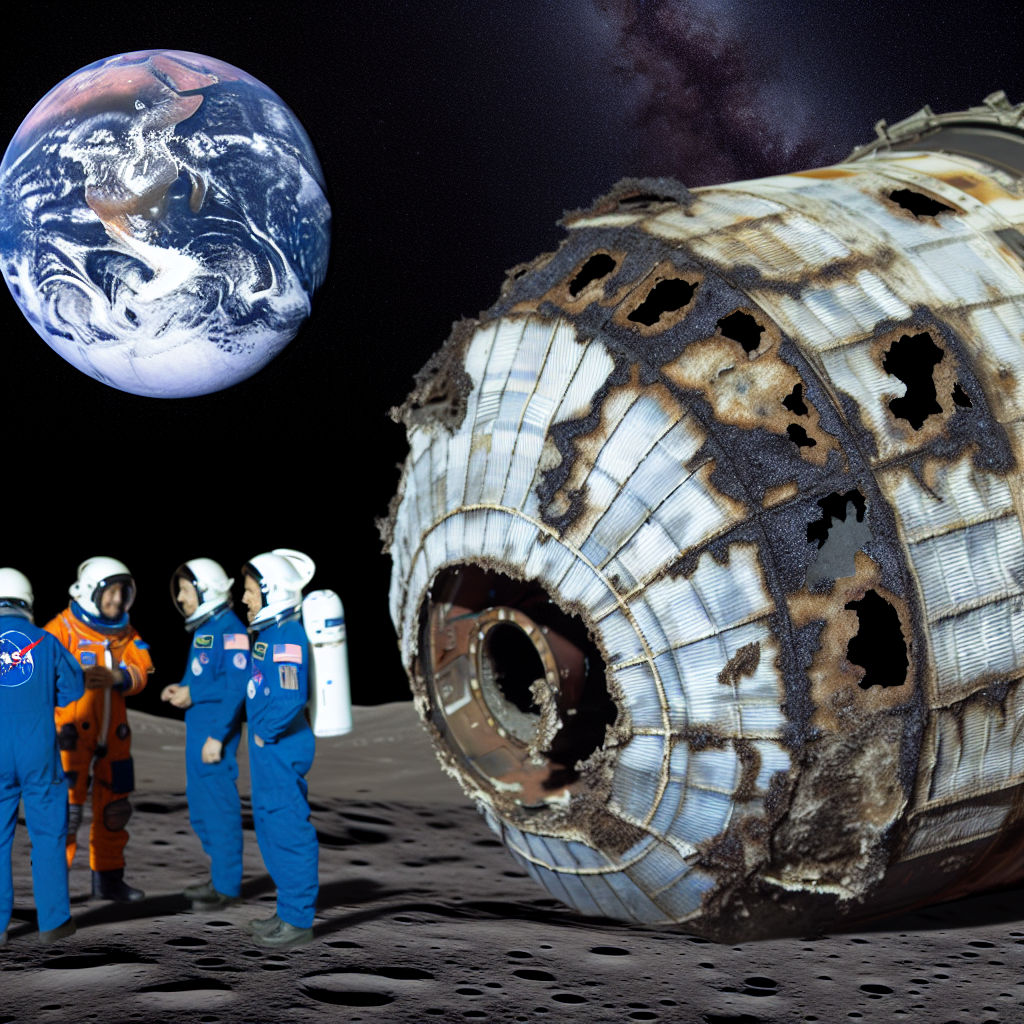Potential Factors Contributing to Orion Heat Shield Issue
NASA’s Orion spacecraft has been the subject of much scrutiny in recent years due to a recurring issue with its heat shield. Despite extensive investigations, NASA has yet to pinpoint the root cause of this problem. In this article, we will explore some potential factors that may be contributing to the Orion heat shield issue.
One possible factor is the material used in the construction of the heat shield. The heat shield is made up of a special type of carbon composite known as Avcoat. This material is designed to withstand the extreme temperatures experienced during re-entry into Earth’s atmosphere. However, there have been concerns that the Avcoat may not be as durable as initially thought. Some experts believe that the material may be degrading over time, leading to the recurring heat shield problem.
Another potential factor is the manufacturing process of the heat shield. The heat shield is composed of several layers, each with specific properties to protect the spacecraft from the intense heat. If any of these layers are not properly bonded or if there are defects in the manufacturing process, it could compromise the integrity of the heat shield. This could explain why the issue keeps resurfacing despite NASA’s efforts to address it.
Furthermore, the design of the heat shield itself may be contributing to the problem. The heat shield is a complex structure that must be precisely engineered to withstand the extreme conditions of re-entry. Any flaws or weaknesses in the design could result in the recurring issue with the heat shield. NASA has been working closely with its engineers and contractors to analyze the design and identify any potential areas for improvement.
In addition to these factors, the intense forces experienced during launch and re-entry could also be playing a role in the heat shield issue. The spacecraft is subjected to extreme vibrations and accelerations during these phases, which could put stress on the heat shield. Over time, this stress could lead to the degradation or failure of the heat shield, causing the recurring problem.
Despite the ongoing investigations, NASA has not yet been able to definitively determine the root cause of the Orion heat shield issue. The agency continues to analyze data from previous missions and conduct extensive testing to gain a better understanding of the problem. NASA is also exploring alternative materials and manufacturing processes that could potentially address the issue.
In conclusion, the Orion heat shield issue remains a perplexing challenge for NASA. Potential factors contributing to the problem include the material used in the heat shield, the manufacturing process, the design, and the intense forces experienced during launch and re-entry. NASA is actively working to identify the root cause of the issue and develop solutions to ensure the safety and success of future Orion missions.
Ongoing Investigations into Orion Heat Shield Problem

NASA’s Orion spacecraft has been the subject of ongoing investigations due to a heat shield problem that has yet to be fully understood. The heat shield is a critical component of the spacecraft, designed to protect it from the intense heat generated during re-entry into Earth’s atmosphere. However, during a test flight in 2014, the heat shield experienced unexpected damage, raising concerns about its reliability and safety.
Since the incident, NASA has been working diligently to determine the root cause of the heat shield problem. The agency has conducted numerous tests and analyses, but so far, a definitive answer has eluded them. This lack of understanding has prompted further investigations and a commitment to finding a solution before any manned missions are undertaken.
One of the main challenges in understanding the heat shield issue is the complexity of the problem itself. The heat shield is composed of multiple layers of materials, each with its own unique properties and characteristics. Understanding how these layers interact and respond to the extreme conditions of re-entry is no easy task. NASA scientists and engineers have been conducting extensive simulations and experiments to gain insights into the behavior of the heat shield, but progress has been slow.
Another factor complicating the investigation is the limited availability of data from the test flight. Due to a malfunction in the data recording system, crucial information about the conditions experienced by the heat shield during re-entry was lost. This has made it difficult for NASA to accurately recreate the events and pinpoint the exact cause of the damage. However, the agency has been able to gather some data from other sources, such as sensors on the spacecraft, which has provided valuable insights into the problem.
In addition to conducting their own investigations, NASA has also sought external expertise to help shed light on the issue. The agency has collaborated with industry partners, academic institutions, and other government agencies to pool resources and knowledge. This collaborative approach has allowed for a broader range of perspectives and expertise to be brought to bear on the problem. However, despite these efforts, a definitive answer remains elusive.
The lack of a clear understanding of the root cause of the heat shield problem has understandably raised concerns about the safety of future manned missions. NASA is acutely aware of these concerns and has made it a top priority to resolve the issue before any astronauts are put at risk. The agency has implemented a rigorous testing and evaluation process to ensure that the heat shield meets the highest standards of safety and reliability.
While the investigation into the Orion heat shield problem is ongoing, NASA remains committed to finding a solution. The agency’s scientists and engineers continue to work tirelessly to unravel the complexities of the issue and develop a comprehensive understanding of the root cause. Through collaboration, experimentation, and analysis, NASA is confident that a resolution will be found, ensuring the safety and success of future manned missions.
In conclusion, the ongoing investigations into the Orion heat shield problem highlight the challenges and complexities involved in understanding such a critical component of spacecraft. NASA’s commitment to finding a solution and ensuring the safety of future missions is evident in their collaborative approach and rigorous testing process. While the root cause of the heat shield problem remains unknown, the agency’s dedication to resolving the issue instills confidence that a solution will be found.
Implications of NASA’s Continued Lack of Understanding on Orion Heat Shield
NASA’s Orion spacecraft has been hailed as the future of human space exploration, with its ability to carry astronauts to the Moon and beyond. However, recent developments have raised concerns about the spacecraft’s heat shield, which is crucial for protecting the crew during re-entry into Earth’s atmosphere. Despite extensive testing and analysis, NASA still does not fully understand the root cause of the heat shield issue, and this lack of understanding has significant implications for the future of the Orion program.
The heat shield is a critical component of any spacecraft, as it is responsible for dissipating the intense heat generated during re-entry. Without a properly functioning heat shield, the crew would be exposed to temperatures that could be fatal. Therefore, it is essential to thoroughly understand the root cause of any issues with the heat shield to ensure the safety of future missions.
NASA has been investigating the heat shield issue for several years now, conducting numerous tests and simulations to identify the problem. However, despite these efforts, the exact cause of the issue remains elusive. This lack of understanding is concerning, as it raises questions about the reliability and safety of the Orion spacecraft.
One implication of NASA’s continued lack of understanding is the potential for delays in future missions. If the root cause of the heat shield issue is not identified and resolved, it may be necessary to postpone or even cancel upcoming missions. This would not only be a setback for NASA’s exploration goals but also a disappointment for the scientific community and the general public, who have been eagerly anticipating the next steps in human space exploration.
Another implication is the increased risk to astronaut safety. Without a clear understanding of the heat shield issue, there is a higher chance of a catastrophic failure during re-entry. This could result in the loss of crew members and a devastating blow to the future of human space exploration. It is crucial for NASA to prioritize the investigation of the heat shield issue to mitigate these risks and ensure the safety of astronauts.
Furthermore, the lack of understanding surrounding the heat shield issue raises concerns about the overall reliability of the Orion spacecraft. If NASA cannot identify and resolve this problem, it raises questions about the potential for other unknown issues that may arise during future missions. This uncertainty undermines confidence in the spacecraft and may lead to a loss of public support and funding for the program.
To address these implications, NASA must continue its efforts to understand the root cause of the heat shield issue. This may involve further testing, analysis, and collaboration with experts in the field. It is essential for NASA to leave no stone unturned in their pursuit of knowledge and to prioritize the safety of astronauts above all else.
In conclusion, NASA’s lack of understanding regarding the root cause of the Orion heat shield issue has significant implications for the future of the program. Delays in missions, increased risk to astronaut safety, and concerns about overall spacecraft reliability are just a few of the consequences of this lack of understanding. To mitigate these implications, NASA must redouble its efforts to identify and resolve the heat shield issue. Only through a thorough understanding of the problem can NASA ensure the safety and success of future missions and maintain public support for the Orion program.


